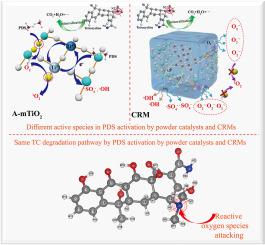当前位置:
X-MOL 学术
›
Environ. Pollut.
›
论文详情
Our official English website, www.x-mol.net, welcomes your feedback! (Note: you will need to create a separate account there.)
Comparative study of reactive oxygen species and tetracycline degradation pathways in catalytic peroxodisulfate activation by asymmetric mesoporous TiO2 and the corresponding controlled-release materials
Environmental Pollution ( IF 8.9 ) Pub Date : 2024-03-25 , DOI: 10.1016/j.envpol.2024.123813 Ting Wang , Rui Huang , Hua-Li Chen , Kun-Miao Xu , Li-Guang Wu , Kou-Ping Chen , Ji-Chun Wu
Environmental Pollution ( IF 8.9 ) Pub Date : 2024-03-25 , DOI: 10.1016/j.envpol.2024.123813 Ting Wang , Rui Huang , Hua-Li Chen , Kun-Miao Xu , Li-Guang Wu , Kou-Ping Chen , Ji-Chun Wu

|
The removal of trace amounts of antibiotics from water environments while simultaneously avoiding potential environmental hazards during the treatment is still a challenge. In this work, green, harmless, and novel asymmetric mesoporous TiO (A-mTiO) was combined with peroxodisulfate (PDS) as active components in a controlled-release material (CRM) system for the degradation of tetracycline (TC) in the dark. The formation of reactive oxygen species (ROS) and the degradation pathways of TC during catalytic PDS activation by A-mTiO powder catalysts and the CRMs were thoroughly studied. Due to its asymmetric mesoporous structure, there were abundant Ti/Ti couples and oxygen vacancies in A-mTiO, resulting in excellent activity in the activation of PDS for TC degradation, with a mineralization rate of 78.6%. In CRMs, ROS could first form during PDS activation by A-mTiO and subsequently dissolve from the CRMs to degrade TC in groundwater. Due to the excellent performance and good stability of A-mTiO, the resulting constructed CRMs could effectively degrade TC in simulated groundwater over a long period (more than 20 days). From electron paramagnetic resonance analysis and TC degradation experiments, it was interesting to find that the ROS formed during PDS activation by A-mTiO powder catalysts and CRMs were different, but the degradation pathways for TC were indeed similar in the two systems. In PDS activation by A-mTiO, besides the free hydroxyl radical (·OH), singlet oxygen (O) worked as a major ROS participating in TC degradation. For CRMs, the immobilization of A-mTiO inside CRMs made it difficult to capture superoxide radicals (·O), and continuously generate O. In addition, the formation of sulfate radicals (·SO), and ·OH during the release process of CRMs was consistent with PDS activation by the A-mTiO powder catalyst. The eco-friendly CRMs had a promising potential for practical application in the remediation of organic pollutants from groundwater.
中文翻译:

不对称介孔TiO2和相应控释材料催化过二硫酸盐活化过程中活性氧和四环素降解途径的比较研究
从水环境中去除微量抗生素,同时避免处理过程中潜在的环境危害仍然是一个挑战。在这项工作中,绿色、无害的新型不对称介孔二氧化钛(A-mTiO)与过二硫酸盐(PDS)作为活性成分结合在控释材料(CRM)系统中,用于在黑暗中降解四环素(TC)。深入研究了 A-mTiO 粉末催化剂和 CRM 催化 PDS 活化过程中活性氧 (ROS) 的形成和 TC 的降解途径。由于其不对称介孔结构,A-mTiO2中存在丰富的Ti/Ti对和氧空位,使得PDS活化降解TC具有优异的活性,矿化率为78.6%。在 CRM 中,ROS 在 A-mTiO 活化 PDS 过程中首先形成,随后从 CRM 中溶解,降解地下水中的 TC。由于A-mTiO优异的性能和良好的稳定性,所构建的CRM可以在很长一段时间内(超过20天)有效降解模拟地下水中的TC。通过电子顺磁共振分析和TC降解实验,有趣的是,A-mTiO粉末催化剂和CRM在PDS活化过程中形成的ROS不同,但两个体系中TC的降解途径确实相似。在A-mTiO活化PDS中,除了自由基(·OH)之外,单线态氧(O)也是参与TC降解的主要ROS。对于CRM而言,A-mTiO在CRM内部的固定化使其难以捕获超氧自由基(·O),并不断产生O。此外,在CRM的释放过程中会形成硫酸根(·SO)和·OH与 A-mTiO 粉末催化剂的 PDS 活化一致。环保型CRM在修复地下水有机污染物方面具有广阔的实际应用潜力。
更新日期:2024-03-25
中文翻译:

不对称介孔TiO2和相应控释材料催化过二硫酸盐活化过程中活性氧和四环素降解途径的比较研究
从水环境中去除微量抗生素,同时避免处理过程中潜在的环境危害仍然是一个挑战。在这项工作中,绿色、无害的新型不对称介孔二氧化钛(A-mTiO)与过二硫酸盐(PDS)作为活性成分结合在控释材料(CRM)系统中,用于在黑暗中降解四环素(TC)。深入研究了 A-mTiO 粉末催化剂和 CRM 催化 PDS 活化过程中活性氧 (ROS) 的形成和 TC 的降解途径。由于其不对称介孔结构,A-mTiO2中存在丰富的Ti/Ti对和氧空位,使得PDS活化降解TC具有优异的活性,矿化率为78.6%。在 CRM 中,ROS 在 A-mTiO 活化 PDS 过程中首先形成,随后从 CRM 中溶解,降解地下水中的 TC。由于A-mTiO优异的性能和良好的稳定性,所构建的CRM可以在很长一段时间内(超过20天)有效降解模拟地下水中的TC。通过电子顺磁共振分析和TC降解实验,有趣的是,A-mTiO粉末催化剂和CRM在PDS活化过程中形成的ROS不同,但两个体系中TC的降解途径确实相似。在A-mTiO活化PDS中,除了自由基(·OH)之外,单线态氧(O)也是参与TC降解的主要ROS。对于CRM而言,A-mTiO在CRM内部的固定化使其难以捕获超氧自由基(·O),并不断产生O。此外,在CRM的释放过程中会形成硫酸根(·SO)和·OH与 A-mTiO 粉末催化剂的 PDS 活化一致。环保型CRM在修复地下水有机污染物方面具有广阔的实际应用潜力。



























 京公网安备 11010802027423号
京公网安备 11010802027423号